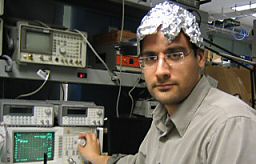
"And now we might add something concerning a certain most subtle spirit which pervades and lies hid in all gross bodies; by the force and action of which spirit the particles of bodies attract one another at near distances, and cohere, if contiguous; and electric bodies operate to greater distances, as well repelling as attracting the neighboring corpuscles; and light is emitted, reflected, refracted, inflected, and heats bodies; and all sensation is excited, and the members of animal bodies move at the command of the will, namely, by the vibrations of this spirit, mutually propagated along the solid filaments of the nerves, from the outward organs of sense to the brain, and from the brain into the muscles. But these are things that cannot be explained in few words, nor are we furnished with that sufficiency of experiments which is required to an accurate determination and demonstration of the laws by which this electric and elastic spirit operates." -- Isaac Newton, alchemist/mathematician, Principia, 1687
Science Daily: Scientists Open Electrical Link to Living Cells.
ScienceDaily (Oct. 23, 2010) — The Terminator. The Borg. The Six Million Dollar Man. Science fiction is ripe with biological beings armed with artificial capabilities. In reality, however, the clunky connections between living and non-living worlds often lack a clear channel for communication. Now, scientists with the Lawrence Berkeley National Laboratory (Berkeley Lab) have designed an electrical link to living cells engineered to shuttle electrons across a cell's membrane to an external acceptor along a well-defined path. This direct channel could yield cells that can read and respond to electronic signals, electronics capable of self-replication and repair, or efficiently transfer sunlight into electricity.
"Melding the living and non-living worlds is a canonical image in science fiction," said Caroline Ajo-Franklin, a staff scientist in the Biological Nanostructures Facility at the Molecular Foundry. "However, in most attempts to interface living and non-living systems, you poke cells with a sharp hard object, and the cells respond in a predictable way -- they die. Yet, in Nature many organisms have evolved to interact with the rocks and minerals that are part of their environment. Here, we took inspiration from Nature's approach and actually grew the connections out of the cell."
Coaxing electrons across a cellular membrane is not trivial: attempts to pull an electron from a cell may disrupt its function, or kill the entire cell in the process. What's more, current techniques to transfer cellular electrons to an external source lack a molecular roadmap, which means even if electrons do turn up outside a cell, there is no way to direct their behavior, see where they stopped along the way, or send a signal back to the cell's interior.
"We were interested in finding a pathway that wouldn't kill the living systems we were studying," said Heather Jensen, a graduate student at University of California, Berkeley whose thesis work is part of this publication. "By using a living system in electronics, we can one day create biotechnologies that can repair and self-replicate."





















